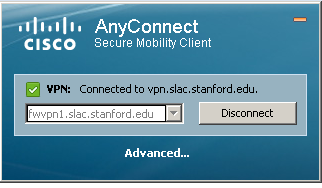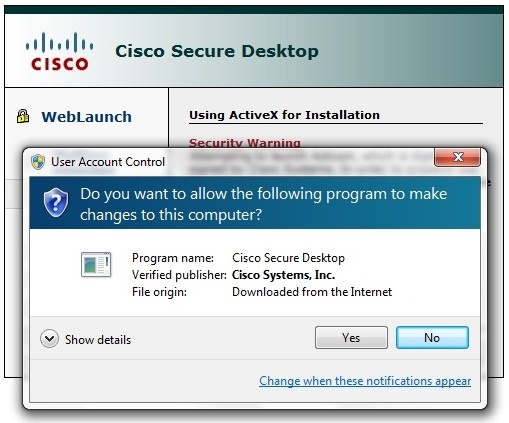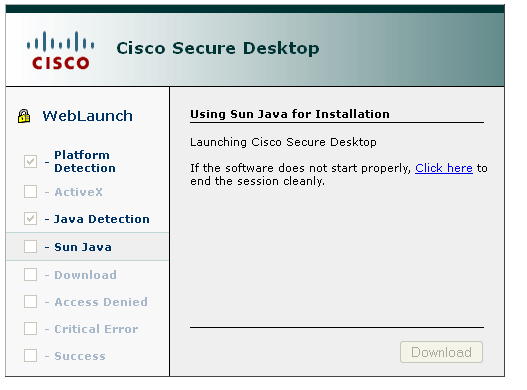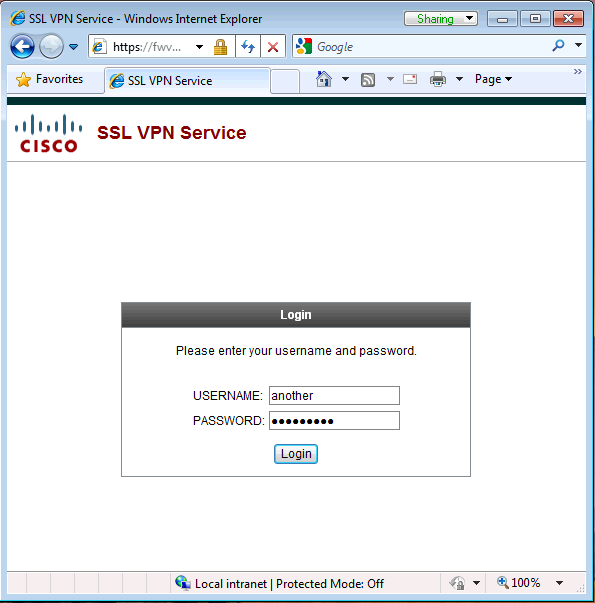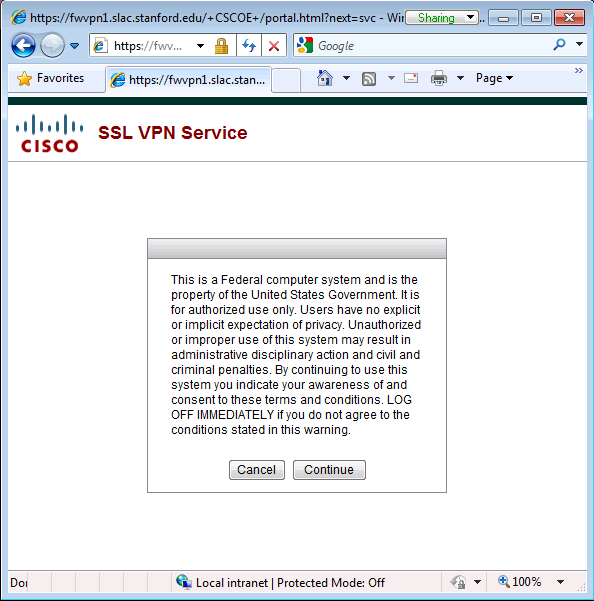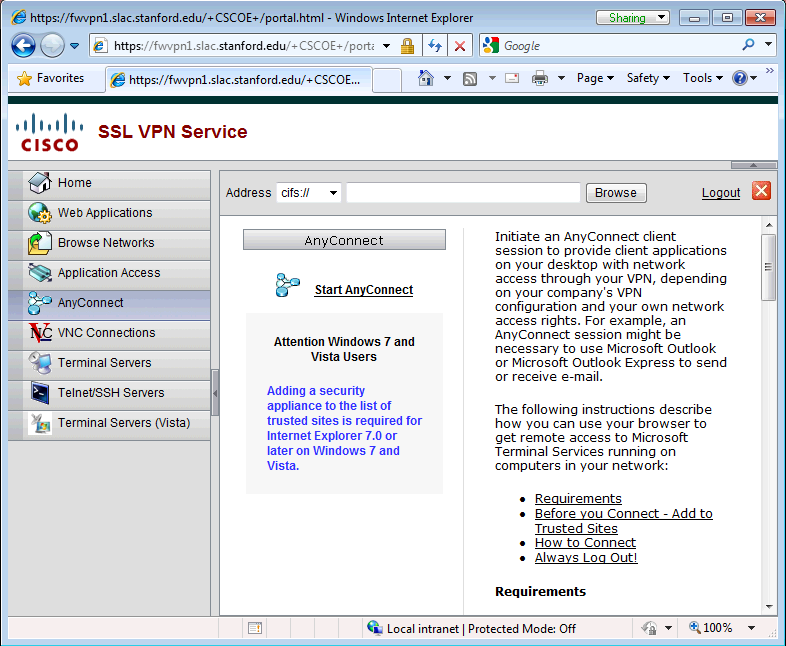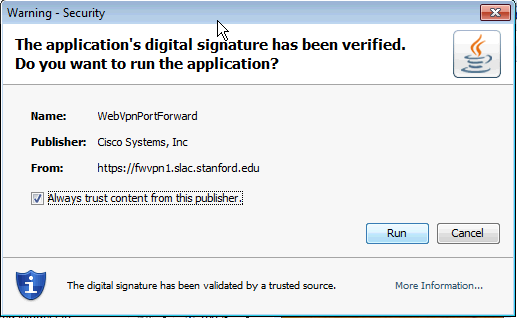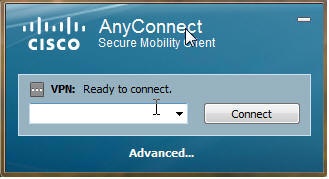Quick instruction guide
Open a web browser and go to https://vpn.slac.stanford.edu/ , logon with your SLAC's windows credentials. Username must NOT be prefixed with "SLAC\". Then click on "Start AnyConnect". The VPN client will be installed/upgraded if necessary before connecting you.
On a SLAC built windows device the vpn client is pre-installed, so you can just go on start menu -> launch Cisco Anyconnect Secure mobility client. Then ensure the connection string is "vpn.slac.stanford.edu" and click on connect. Enter your SLAC's windows credentials, accept the banner and you are connected.
More detailed information are available below.
Table of Contents
- Introduction
- Requirements
- Connecting to the SLAC VPN Using Linux
- Connecting to the SLAC VPN Using Mac OS X
- Connecting to the SLAC VPN Using Windows
- Frequently Asked Questions (FAQs)
- Troubleshooting
Introduction
This page documents the use of the SLAC VPN service.
Virtual Private Network (VPN) provides a secure connection between your computer and the resources available at your home institution. In the case of SLAC, we offer a VPN service that permits authorized users to gain visibility of SLAC network resources from outside of SLAC. This includes the SLAC Visitor Wireless network.
Assistance with installation and usage of this system is available. If you experience difficulties connecting, first visit the VPN Troubleshooting Page. If you are still experiencing problems, please email net-admin@slac.stanford.edu to open a trouble ticket. IT Department Support can also provide assistance with the installation process, they can be reached at ithelp@slac.stanford.edu .
Requirements
- You must have a SLAC Windows account
- Your account must be given SLAC VPN account access, and you must agree to the usage policies outlined. If you have been a user of the older SLAC VPN (2010 or before), then your account likely already has this access permission applied.
- The following operating systems are currently supported (see Frequently Asked Questions page for iPhone/iPad and additional options):
- Windows XP SP3
- Windows Vista
- Windows 7 SP1
- Mac OSX Snow Leopard and more recent versions
- Linux
Please note that if you are using virtualization software such as VMWare, the VPN client may not be able to run inside the virtual machine. VMWare seems to function properly if the network is configured to connect to the network in Bridged mode.
Security
The SLAC VPN connects you directly to the SLAC network. All of your network traffic is sent across an encrypted link, including Internet traffic. You should adhere to the same SLAC computing policies that you do when using computers on-site. Remember to disconnect from the VPN before leaving any computer unattended.
Connecting to the SLAC VPN Using Linux
These instructions are hosted on a separate page. Please visit: Connecting to SLAC's VPN Using Linux
Connecting to the SLAC VPN Using Mac OS X
These instructions are hosted on a separate page. Please visit: Connecting to SLAC's VPN Using Mac OS X
Connecting to the SLAC VPN Using Windows
Open a Web Browser to our VPN Gateway
Note: it is recommended that the following steps be performed using Internet Explorer instead of Firefox or Chrome browsers.
In order to connect to the SLAC VPN, you must have the AnyConnect software installed. By going to the following webpage, we can check to make sure you have the correct software installed and configured (and up to date), and provide an automated install if it is not.
- Goto:
https://vpn.slac.stanford.eduThis URL is a cluster address, it will redirect you toward an available VPN gateway
- Please note the http*s*
Your web browser should come up with the following series of screens
Allow Cisco Secure Desktop to Check Your System
The web page will instantiate a java applet so that it may check your system for the presence of the AnyConnect software.
This may bring up a dialog box which will prompt you to run the application or not.
- If you do not wish to see this dialog again in the future, select 'Always trust content from this publisher'
- Click on 'Run' to allow the applet to scan your system
Log In
The following web page will be presented upon the initial system scan:
- Enter your provided VPN credentials.
- For an account, goto SLAC VPN Accounts
Agree to the Banner
Upon successful login, a banner will be shown on the webpage.
- Click Continue
Initiate the AnyConnect Client
A webpage that offers various methods to access the SLAC VPN services will be presented. Click on Start Anyconnect.
Install the AnyConnect Software (if required)
If you have problems installing the AnyConnect Client, please refer to the Troubleshooting section of this document.
If necessary (either because it is your first time accessing SLAC's VPN, or if there is a new version of the AnyConnect client), the web page will present that the AnyConnect software needs to be installed.
- If you do not wish to see this dialog again in the future, select 'Always trust content from this publish'
- Click on 'Run' to install the AnyConnect Client onto your system.
Editing the hostname within the VPN client.
- Sometimes manual installation does not automatically fill in the server list. If the hostname does not appear in the VPN client, i.e. it appears as:
Enter in the textbox the hostname: vpn.slac.stanford.edu This is a cluster address transparently using an available vpn gateway.
You have connected to SLAC's VPN Service
Upon successful VPN negotiation, you should get the following popup from AnyConnect showing that you have connected to SLAC's VPN service. You may now close this webpage and you will remain connected.
Disconnecting from the SLAC VPN
The AnyConnect client exists as a tray icon; you can get to it from the System tray next to the clock in the bottom right of your screen.
- To disconnect click on 'Disconnect'
An common request from users is to be able to map drive, this is working when connected through the VPN. Documentation from the windows team is here: http://www2.slac.stanford.edu/comp/windows/docs/VPN/VPN.aspx
What to Do if You Have Problems
If you have problems, start by visiting these pages to see if they answer your question:



